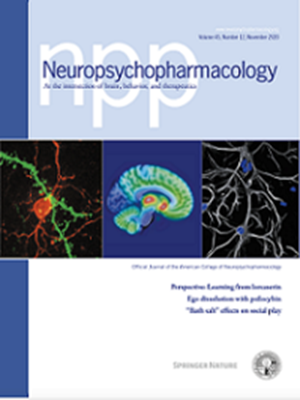Epac2介导的Ca2+可渗透AMPARs突触插入累加核有助于可卡因渴求的潜伏。
IF 6.6
1区 医学
Q1 NEUROSCIENCES
引用次数: 0
摘要
在伏隔核(NAc)的中棘神经元(MSNs)中,缺乏glua2的Ca2+可渗透AMPARs (CP-AMPARs)的积累是可卡因渴求的潜伏期表达所必需的。由cAMP直接激活的交换蛋白(Epac)是cAMP的细胞内效应蛋白和小GTPase Rap1的鸟嘌呤核苷酸交换因子。Epac2参与中枢突触AMPA受体的转运。我们验证了Epac2激活有助于NAc msn中cp - ampar的积累和可卡因渴求的潜伏期的假设。在这里,我们证明了选择性Epac2激动剂S-220促进了缺乏glua2的cp - ampar在兴奋性突触插入到NAc msn上。此外,大鼠长期戒断可卡因导致NAc中Rap1-GTP水平升高,这表明Epac2在孵育期间被激活。重要的是,我们发现aav介导的NAc核心中Epac2的shRNA敲低减轻了长期戒断可卡因后cp - ampar的积累和线索诱导的药物寻求行为。相比之下,选择性Epac2抑制剂ESI-05对Epac2的急性药理抑制并没有改变孵育期间已经积累的cp - ampar,并且ESI-05在nac内应用并没有显著影响长期戒断后线索诱导的药物寻找。综上所述,这些结果表明Epac2在孵育期间激活,而不是在线索诱导的药物寻找期间激活,导致cp - ampar在NAc msn中积累,这反过来又有助于可卡因渴望的孵育。本文章由计算机程序翻译,如有差异,请以英文原文为准。

Epac2-mediated synaptic insertion of Ca2+-permeable AMPARs in the nucleus accumbens contributes to incubation of cocaine craving
The accumulation of GluA2-lacking Ca2+-permeable AMPARs (CP-AMPARs) in the medium spiny neurons (MSNs) of the nucleus accumbens (NAc) is required for the expression of incubation of cocaine craving. The exchange protein directly activated by cAMP (Epac) is an intracellular effector of cAMP and a guanine nucleotide exchange factor for the small GTPase Rap1. Epac2 has been implicated in the trafficking of AMPA receptors at central synapses. We tested the hypothesis that Epac2 activation contributes to the accumulation of CP-AMPARs in NAc MSNs and incubation of cocaine craving. Here we demonstrate that the selective Epac2 agonist S-220 facilitated the synaptic insertion of GluA2-lacking CP-AMPARs at excitatory synapses onto NAc MSNs. In addition, prolonged abstinence from cocaine self-administration in rats resulted in elevated Rap1-GTP levels in the NAc, implying that Epac2 is activated during incubation. Importantly, we show that AAV-mediated shRNA knockdown of Epac2 in the NAc core attenuated the accumulation of CP-AMPARs and cue-induced drug-seeking behavior after prolonged abstinence from cocaine self-administration. In contrast, acute pharmacological inhibition of Epac2 with the selective Epac2 inhibitor ESI-05 did not alter CP-AMPARs that had already accumulated during incubation, and intra-NAc application of ESI-05 did not significantly affect cue-induced drug seeking following prolonged abstinence. Taken together, these results suggest that Epac2 activation during the period of incubation, but not during cue-induced drug seeking, leads to the accumulation of CP-AMPARs in NAc MSNs, which in turn contributes to incubation of cocaine craving.
求助全文
通过发布文献求助,成功后即可免费获取论文全文。
去求助
来源期刊

Neuropsychopharmacology
医学-精神病学
CiteScore
15.00
自引率
2.60%
发文量
240
审稿时长
2 months
期刊介绍:
Neuropsychopharmacology is a reputable international scientific journal that serves as the official publication of the American College of Neuropsychopharmacology (ACNP). The journal's primary focus is on research that enhances our knowledge of the brain and behavior, with a particular emphasis on the molecular, cellular, physiological, and psychological aspects of substances that affect the central nervous system (CNS). It also aims to identify new molecular targets for the development of future drugs.
The journal prioritizes original research reports, but it also welcomes mini-reviews and perspectives, which are often solicited by the editorial office. These types of articles provide valuable insights and syntheses of current research trends and future directions in the field of neuroscience and pharmacology.
 求助内容:
求助内容: 应助结果提醒方式:
应助结果提醒方式:


